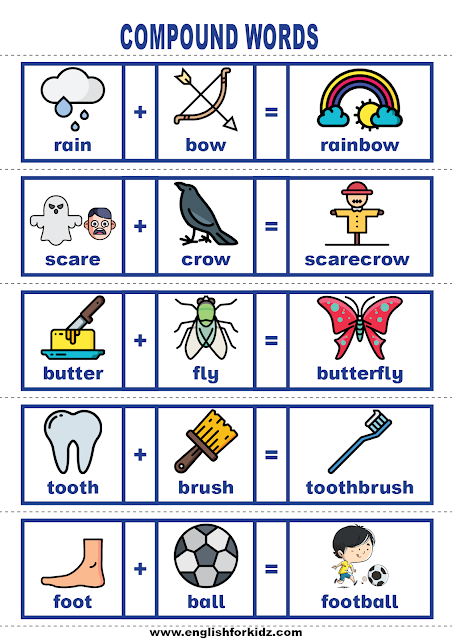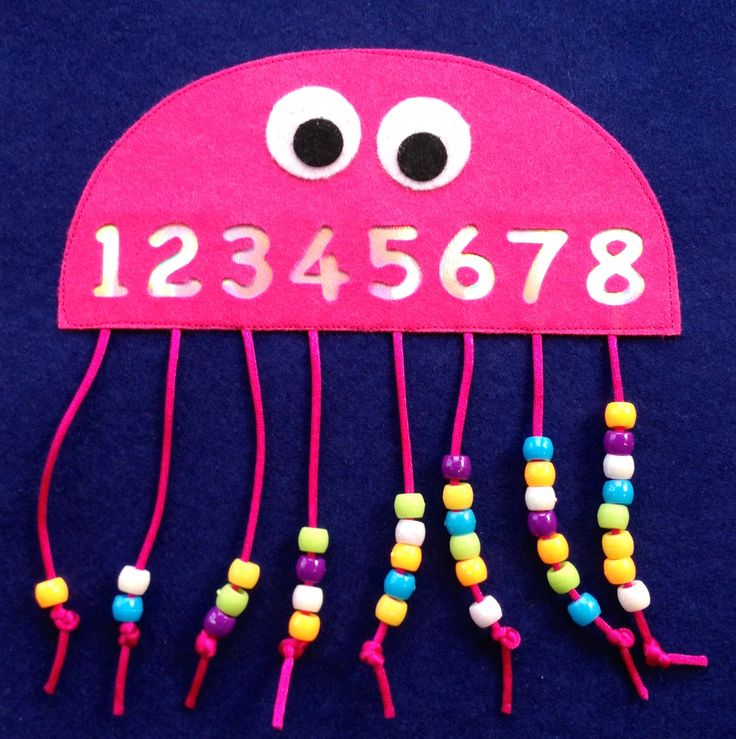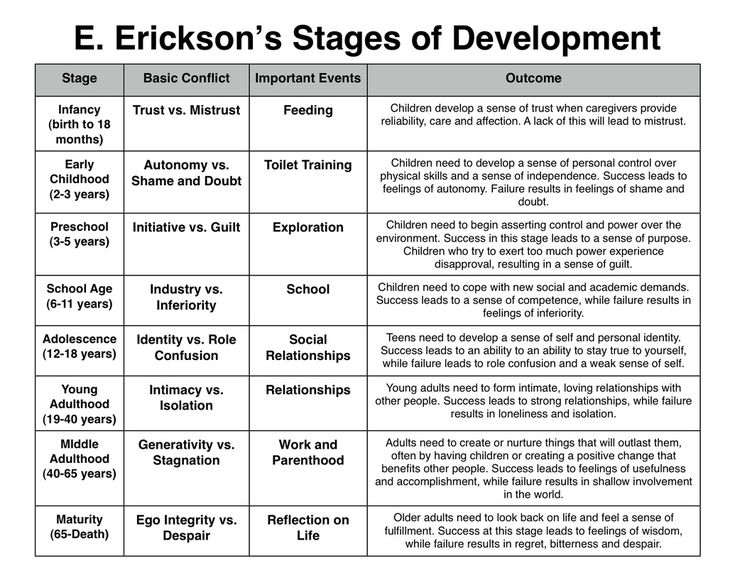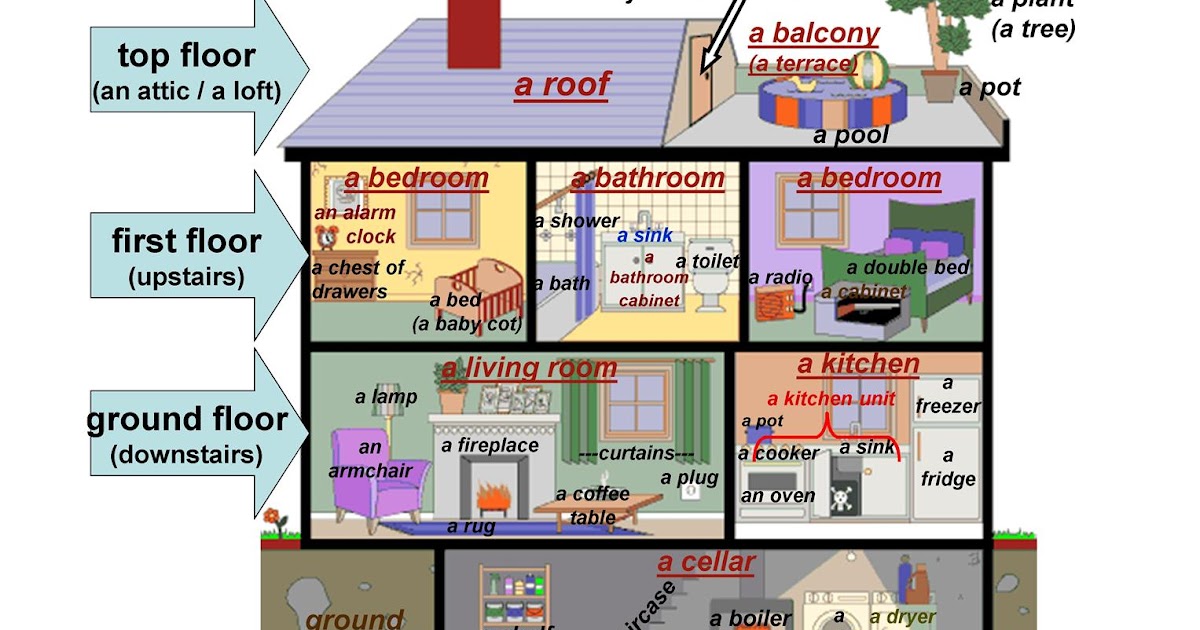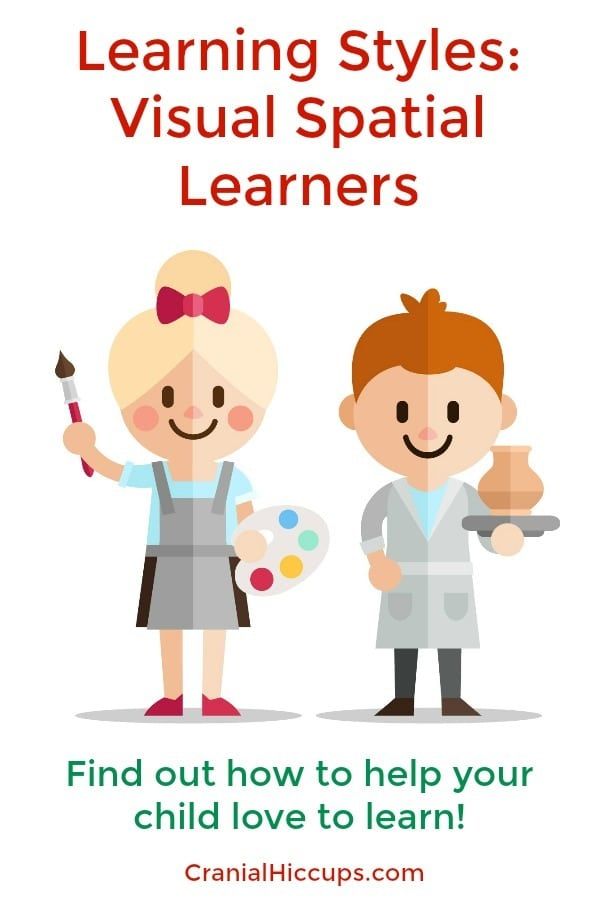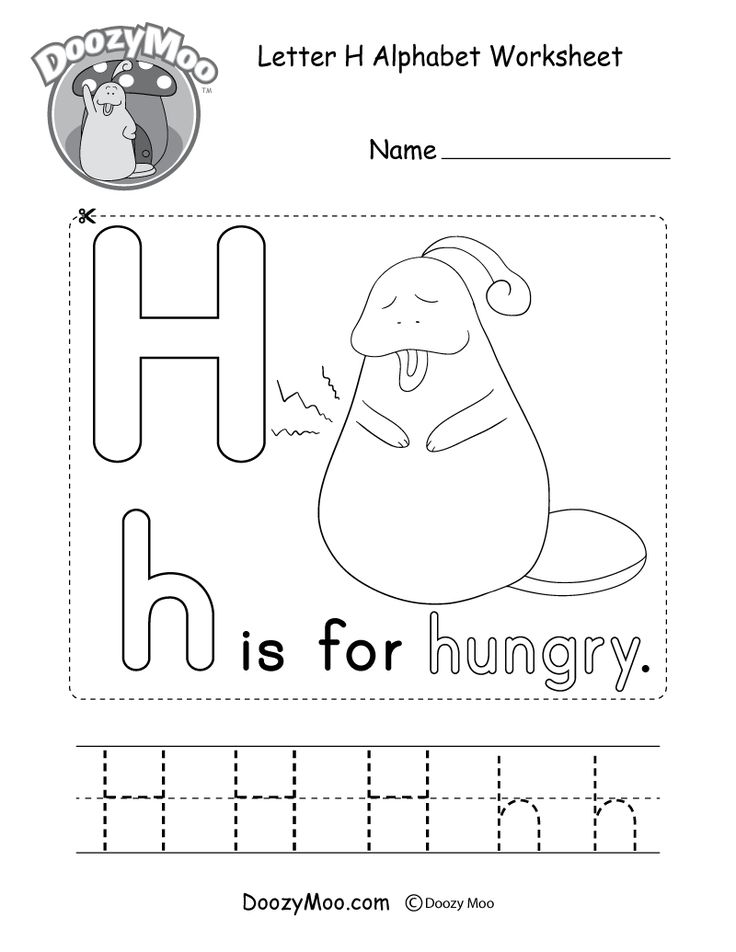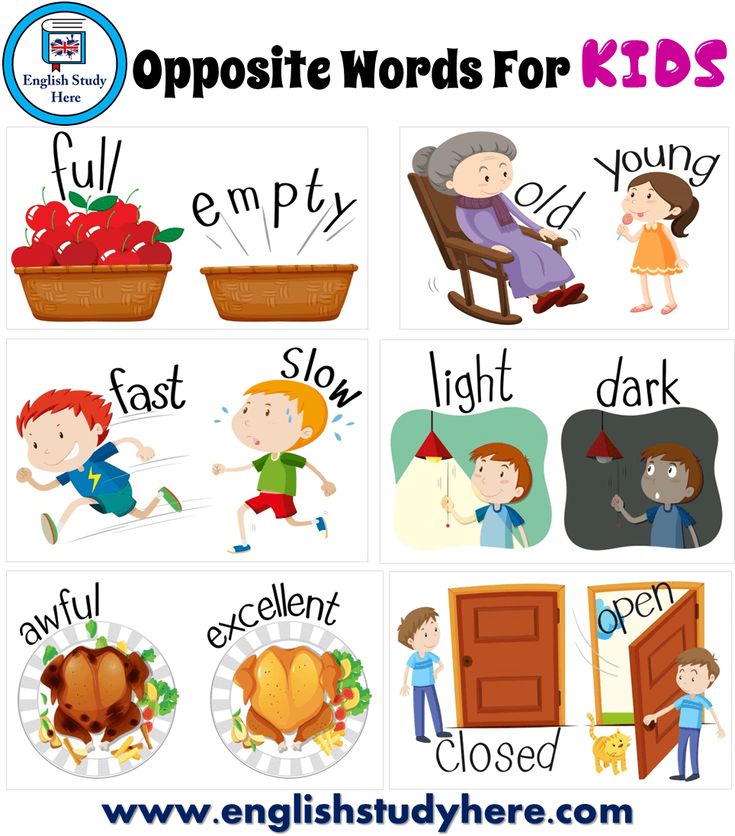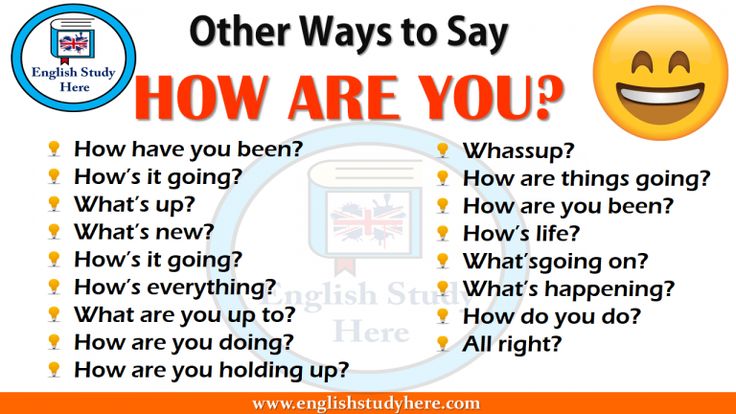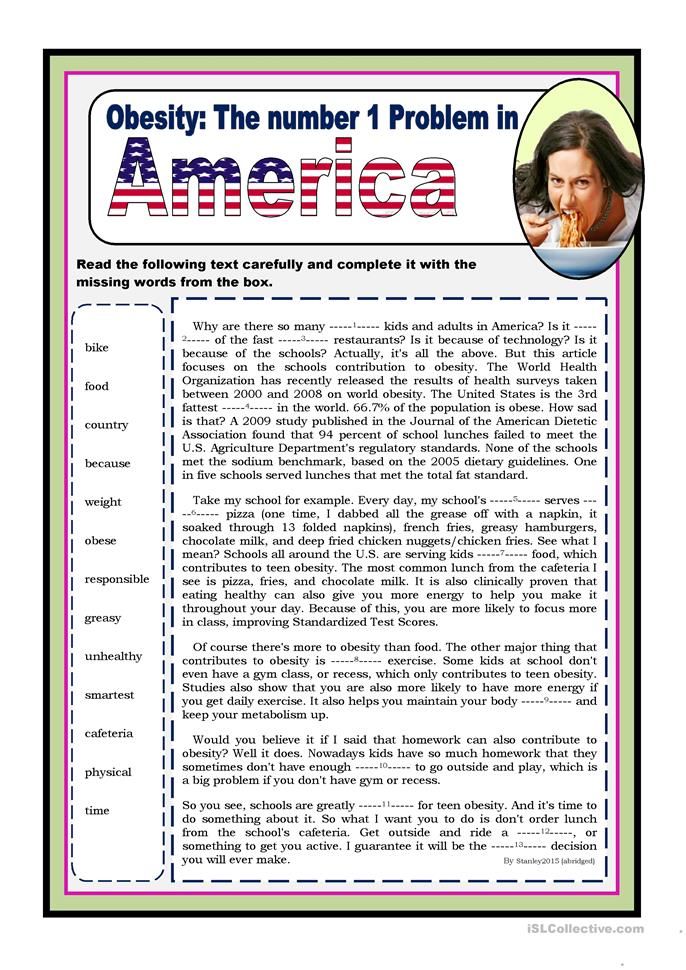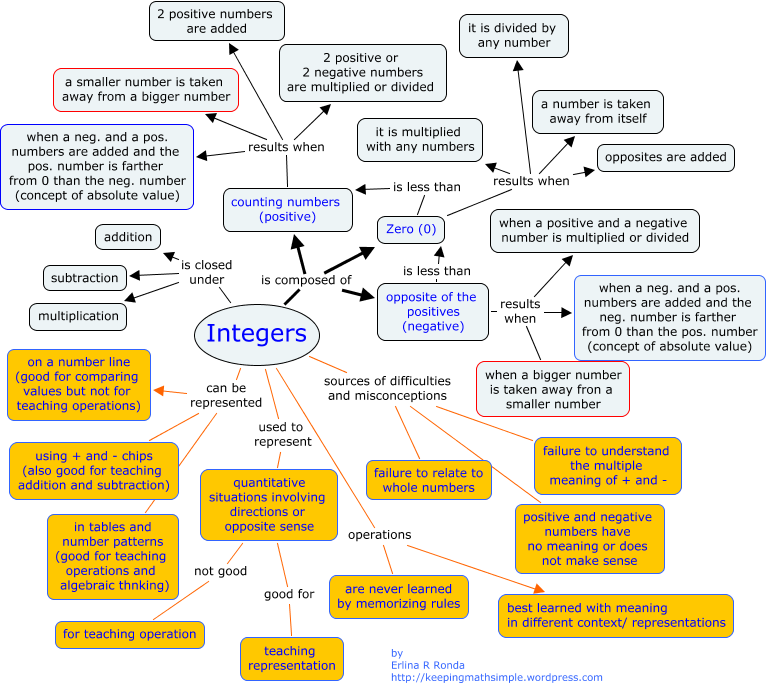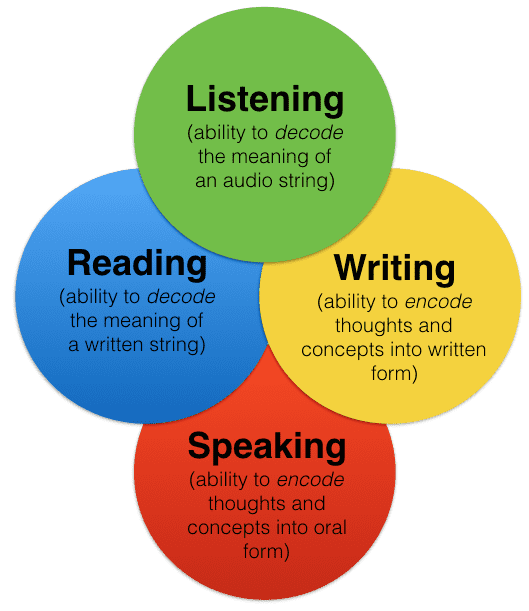Teaching compound words
The 8 Best Compound Word Activities You Need to Try
What do meatballs, butterflies, and cowboys have in common? Not much unless you are teaching compound words to your students this week. This topic can be so fun to teach because of the many different ways you can approach it. Whenever possible, I try to make sure all types of learners’ needs can be met through teaching and activities. I put together a list of some of my favorite compound word activities.
Some of these activities are perfect to use in morning work or literacy stations after students know how to do them. Introduce them during whole group time and then let students keep practicing. These compound word activities were always a hit in my classroom. Most importantly, they helped my students really learn and understand this concept.
Before I jump into the list, I want to share the Compound Words Activities unit. It has everything you’ll need to be totally set for the week teaching compound words. It has a fun character and chant to help you introduce compound words. This unit also has a pocket book, flip book, and picture puzzles. It makes teaching compound words a breeze!
Amazon Affiliate links are used below at no cost to you.
1. Use a song to help you introduce or review compound words.
I love a fun song and video to either kick-off a new concept or to review as we learn. Dr. Jean’s Compound Boogie song is catchy and has great coordinating pictures. It has plenty of examples so your students will really get the hang of it. View it HERE.
2. Create an anchor chart for students to refer to.
A good anchor chart helps make learning visible and accessible to students. It serves a visual reference for students to look to. I love to make one with the definition of a compound word and a few examples. Then, as the week goes on, we’ll take a minute or two each day and add more examples as students come up with them.
Another fun anchor chart to make is compound words that are food. There are so many! I did this as interactive writing. My students loved adding to this chart!
3. Use read alouds for students to practice listening for compound words.
Read alouds are powerful tools that can help reach auditory learners, build background knowledge, and help grow strategic readers. Read alouds also help you integrate topics, like compound words, throughout the day. While you read, have students listen for compound words. You can have them raise their hands when they hear one. Here are a few books to use for compound words:
- Cloudy with a Chance of Meatballs by Judi Barrett
- If You Were a Compound Word by Trisha Speed Shaskan
- Thumbtacks, Earwax, Lipstick, Dipstick: What Is a Compound Word? By Brian P. Cleary
- Once There Was a Bull…Frog by Rick Walton
4. Use Duplo blocks for hands-on practice.
Write words on the blocks by using my favorite Post-It tape on shorter Duplo blocks.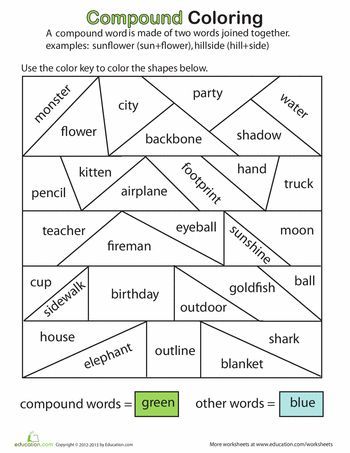 Have students place two short Duplo blocks together on a longer one to make a compound word. If you have very low-level readers, you can simply add pictures. You can have students write the new compound word they created and illustrate it if you want something you can check afterward.
Have students place two short Duplo blocks together on a longer one to make a compound word. If you have very low-level readers, you can simply add pictures. You can have students write the new compound word they created and illustrate it if you want something you can check afterward.
5. Implement self-checking puzzles.
Puzzles are such a great way for students to use their hands and brains while learning. Self-checking puzzles help students immediately see if their thinking is correct or not. Just write a word and draw a simple picture on each side of a notecard. For example, tree and house. Make a unique cut, like a zig-zag, and cut the notecard in half. Create several of these and mix them up.
In my Compound Word Activities Unit, I have this activity already done for you. Plus, there’s a recording page to make it easy for students to jot down their matches and for you to check them.
6. Introduce hands-on games to reinforce learning.
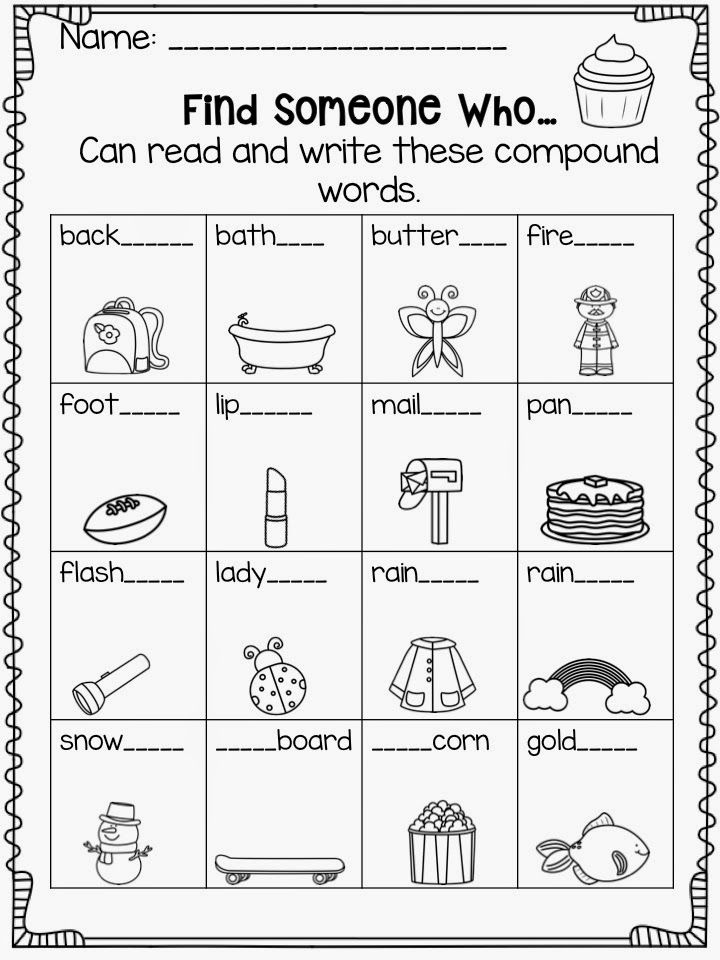
Most students in kindergarten, first grade, and second grade know how to play memory. Add a twist to the classic game with compound words. After you introduce this and model how to play, let students practice. Then, you can use it during morning work or in a word work or game literacy station.
- Make picture word cards for the compound word and its two individual words. For example, treehouse, tree, and house.
- Do this for several compound words.
- Next, flip the cards facedown.
- Students take turns flipping over three cards, saying/reading each one.
- Finally, if they flip over the three cards that go together (tree, house, and treehouse), they get to keep them and get a point.
7. Use online games.
There are several games online that you could use to let students practice identifying and making compound words. If you have iPads, you could use them in literacy stations. Check out what I found on YouTube.
- The Guess the Word Challenge is a video that shows two pictures.
 Students have to guess the compound word before the clock countdown ends.
Students have to guess the compound word before the clock countdown ends. - Similarly, The Compound Word Game is very similar. The main difference is this game does have some audio of someone saying the name of each picture, and the other game has no audio.
You can have students play two ways:
- Think, pair, and share the answer. Give a thumbs up or down if their partner got it correct.
- Let students write or draw the answers on whiteboards and hold them up to show you.
8. Sort compound words and not compound words.
Sorting is one of the higher-level compound word activities on Bloom’s Taxonomy. Show some examples of compound words with pictures and words that are not compound words. Have students sort them.
If you want this activity already all planned and done for you, my Compound Word Activities has this activity in it. Students make a pocket book and sort the pictures. I love sorting this way because it’s interactive, and the students can take the pieces out, mix them up, and sort them again.
I love sorting this way because it’s interactive, and the students can take the pieces out, mix them up, and sort them again.
These eight compound word activities will be sure that the different types of students’ learning needs are met and support your ELL students, too. Remember that with any concept you teach, it’s important to add variety to your lessons and activities. As a result, students will be engaged and learn more effectively.
pin it
Do you have any must-do compound word activities? Leave a comment and let me know!
Shop This Post
Compound Word Activities Unit : This unit has interactive activities to help you teach compound words and help your students master this standard. It includes:
- Fun Compound Word Chant
- Compound Connection Puzzles (18 picture puzzles and recording sheets)
- Compound Connie (character used to help introduce the concept with activities)
- Pocket Book for Compound Word Sort
- Compound Flip Book (creating compound words)
Want to use the latest research to boost your readers during small groups? This FREE guide is packed with engaging ideas to help them grow!
The Essential Guide (+ FREE Downloads)
by Marie Rippel
Compound words are formed when two smaller words combine to form a new word, as in these examples:
mail + box = mailbox
milk + shake = milkshake
note + book = notebook
The resources in this article can help you introduce compound words to your children and make them feel like superheroes for being able to read and spell such long words!
What Is a Compound Word?
Compound words can be lots of fun for young readers and spellers. And they are easier to tackle if we think of compound words as two smaller words that are combined to form a new word.
And they are easier to tackle if we think of compound words as two smaller words that are combined to form a new word.
But there’s another important thing to consider when teaching compound words!
When deciding of a word is a compound, remember that the meaning of the compound word relates to the meanings of the two words that combine to form it. For example, a bathtub is a tub you take a bath in. A sandbox is a box you put sand in. An anthill is a hill made by ants, and so on.
Download This Free List of Compound Words
This big list of kid-friendly compound words will be a great resource as you work on this skill together.
Teach How to Look for the Two Smaller Words in the Compound Word
The easiest way to introduce compound words is with letter tiles. Choose a word such as bathtub from the resource list and build it with the tiles.
Explain to your child that the word bathtub has two smaller words in it, and invite him to find those two smaller words.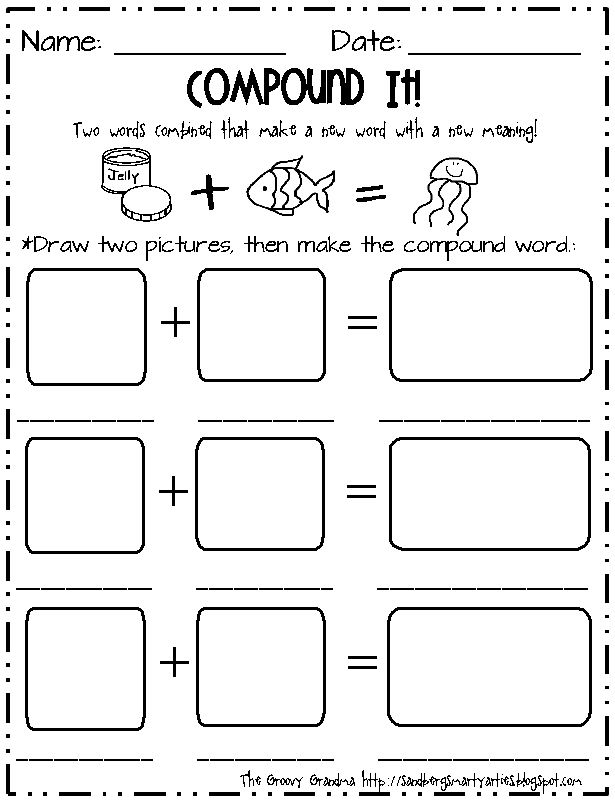 Letter tiles are great for this activity because your child can separate the compound word into two words, like this:
Letter tiles are great for this activity because your child can separate the compound word into two words, like this:
Suddenly, longer words are no longer scary! See why I love letter tiles so much? You can practice this concept with fun words like sandbox, anthill, backpack, and windmill. This is a wonderful method for helping students visualize the words that form compound words.
Games and Activity Sheets for Compound Words
Hands-on games and activities make learning about compound words more fun! Here are three free printables that you can use with your child. The first two activities come from All About Reading Level 1, and the third activity was designed for all reading levels.
“Bird Friends” Activity
Birds of a feather flock together … and in this fun reading activity, birds of a feather make compound words, too! Just have your child select two matching birds and place them side by side on the branch. Each pair of birds makes a compound word!
“Chop-Chop” Activity
Practice compound words with this fun (and safe!) chopping game! Just cut out the knife and the foods, then let your child “chop” each compound word between its two smaller words.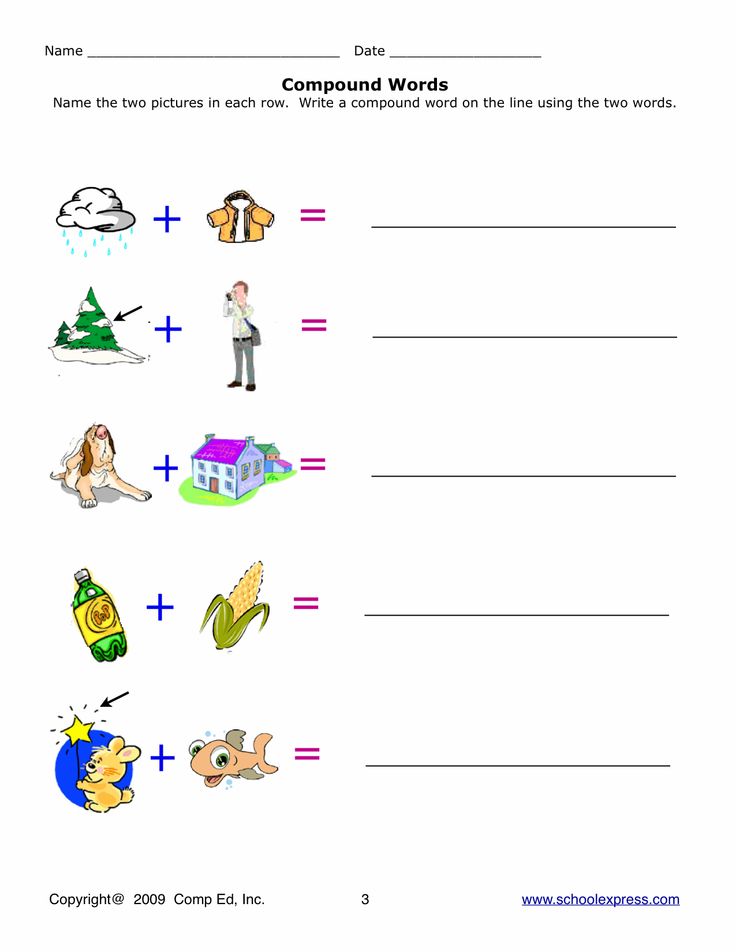 Read each smaller word, and then read the compound word.
Read each smaller word, and then read the compound word.
“Banana Splits” Game
Use compound words to build the yummiest banana split ever in this delicious multi-level reading game. Every player gets an ice cream bowl and a stack of candy covered scoops of ice cream to play with. And the best part? Students of different levels can play together!
Spelling Tips for Compound Words
When your child is spelling, it may not be obvious when to combine two words into one. This process is made more difficult by the fact that there are actually three kinds of compound words. There are closed compounds, which we have been discussing in this article so far. And then there are open compounds and hyphenated compounds.
If your child needs to spell the word ice cream, for example, there is no rule that will help her decide whether this is a closed or open compound word. She’ll just need to determine what “looks right,” and the only way to do that is to have seen it in writing before (preferably multiple times).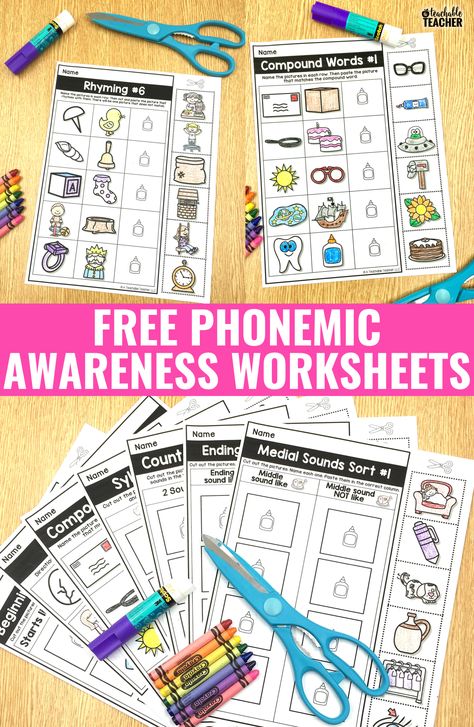 The Practice Sheets in All About Reading and the Word Banks in All About Spelling are excellent tools to do just that.
The Practice Sheets in All About Reading and the Word Banks in All About Spelling are excellent tools to do just that.
Of course, reading word lists isn’t all that exciting. Reading a short story about a sassy cat, on the other hand, is a much more engaging way to practice reading compound words! Here’s the first story with compound words that beginning readers encounter in All About Reading Level 1.
Cobweb the Cat short storyIn this story, young readers encounter fourteen different closed compound words, including bathtub, catfish, and sunset. All of these words are pre-taught through various activities, so even before reading the story, the child has already become familiar with them.
The more times your student sees compound words in print, the easier it will be for him to spell them. And that leads us to our final tip for teaching children to spell compound words…
Provide Oral “Hints” During Spelling Dictation
To increase your child’s awareness of compound words during spelling dictation, provide prompts such as “This next sentence has a compound word. ” After your child sees closed compound words in print a number of times, he’ll begin to get a sense of when to combine two smaller words into one.
” After your child sees closed compound words in print a number of times, he’ll begin to get a sense of when to combine two smaller words into one.
The bottom line when teaching compound words is practice, practice, practice! But make practice a joy by incorporating letter tiles, activity sheets, short reading selections, and spelling dictation “hints.”
What are your favorite ways to practice compound words? Let me know in the comments below!
Compound words
Open lesson of the Russian language.
Teacher Zorina G.A.
Theme "Compound words"
Purpose: To form students' understanding of complex words, to form the ability to correctly write connecting vowels in complex words
Cognitive UUD - develop the ability to independently "read" and explain information; find new ways of learning about the formation of compound words
Communicative UUD - we develop the ability to actively participate in discussions that arise in the lesson, clearly formulate answers to questions from the teacher and other students show cognitive initiative in helping fellow students
Equipment:
Russian language textbook.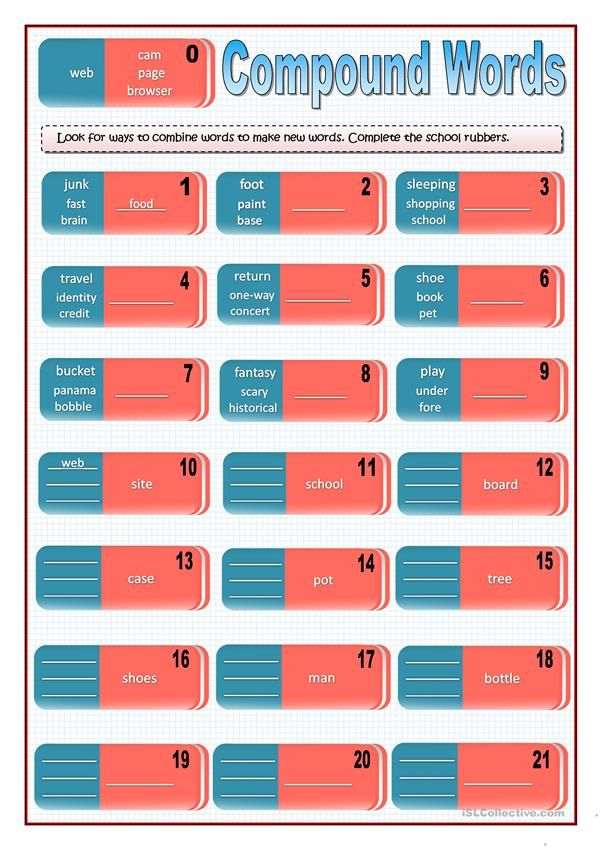 Grade 3 Textbook at 2 hours Klimanova L.F., Babushkina T.V. nine0005
Grade 3 Textbook at 2 hours Klimanova L.F., Babushkina T.V. nine0005
Individual cards, cards for group work. (See Appendix)
Lesson progress.
1. Organizational moment. Emotional mood for the lesson. Motivation for learning activities. 1 min.
Check everything you need for the lesson (notebook, textbook, pen, pencil, helper card, autumn leaves). Smile to each other and give a smile to us. I wish you good mood, good luck, mutual understanding.
2. A minute of calligraphy.2- min. nine0004 Open notebooks. Write down the number and classwork. Look at the blackboard. Continue the pattern eo eo.
3. Updating knowledge.
Let's start our lesson with a motto that will help us get ready for further work.
At the lesson, be ready to reveal the secrets of words.
Let's start our lesson with the disclosure of secret words and at this stage of the lesson we will be researchers.
And to uncover the secrets of words, listen to riddles.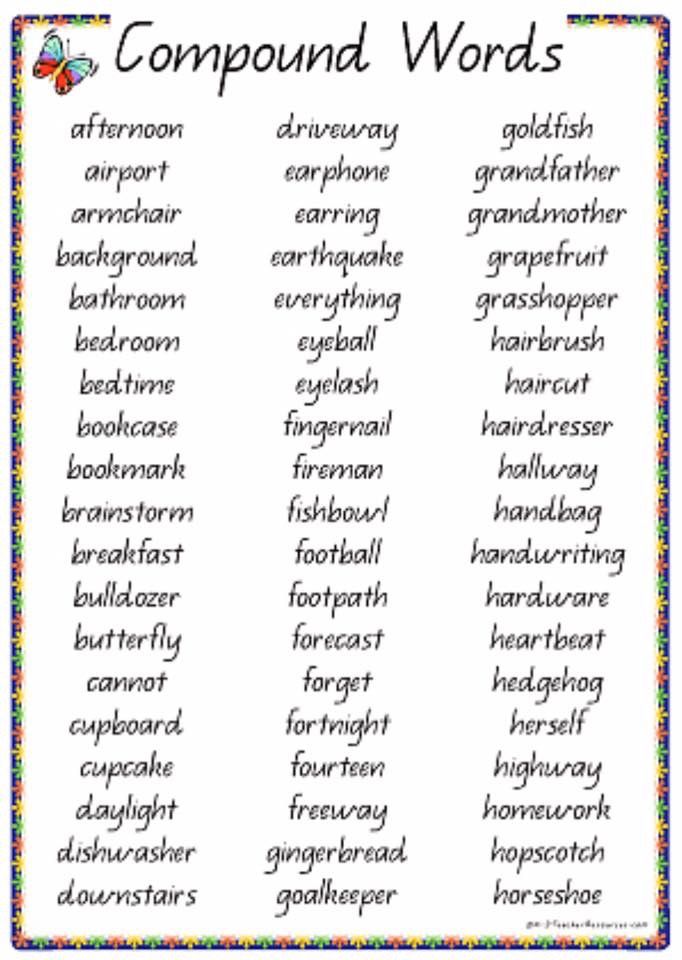 You will write the guessed words in a line, separated by commas. Will help me………
You will write the guessed words in a line, separated by commas. Will help me………
Before writing, let's remember the seating rules at the desk.
1. It has been hanging on a branch since spring,
It was green - turned yellow.
Just a slight wind blew,
He already flew.
\leaf\
0002 4. - natural phenomenon, accompanied by abundant fall of leaves - leaf fall.
We got a chain of words:
LEAF, LEAF, LEAF, LEAF FALL.
- How can you name the chain of these words? - single-rooted ( we select the root).
4. Problem situation.
The word LEAVES FALL caused a problem.
- To understand the lexical meaning of this word, we need two words LEAF and FALL. nine0005
LEAF FALL
Leaf to fall
Let's select a root in them. LEAF and FALL.
And now let's highlight the roots in the word FALLING LEAF.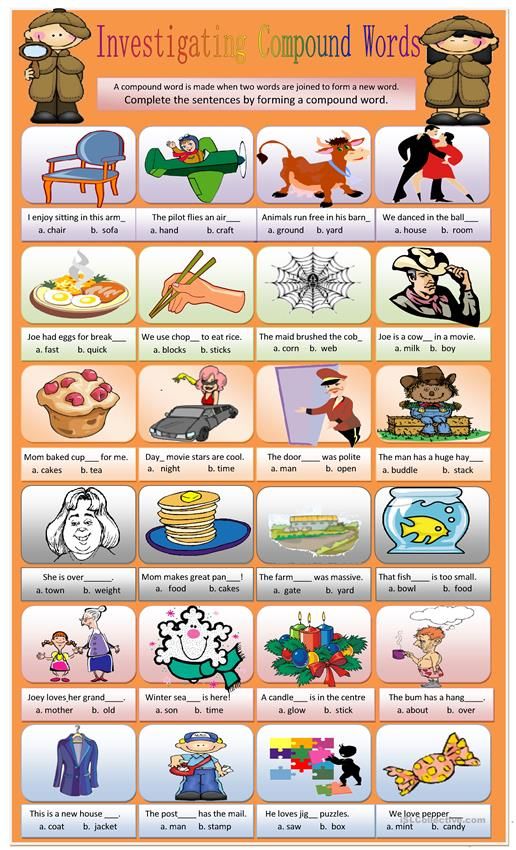
How the word LEAF FALL was formed..
- It is formed by adding two roots LEAF and PAD.
- What connects the roots? (vowel O) It is called the connecting vowel. How can such words be called?
- compound words.
- Name the topic of our lesson - COMPOUND WORDS.
Tell me, guys, have you met compound words before and where? nine0005
5. Learning new material. Research activity. Work in pairs.
And now you work as designers (work in pairs). And you will find out what other secret is hidden by compound words.
Construct and write down words and highlight their roots.
But first, let's do exercises for the eyes.
Close eyes tightly for 3-5 seconds. Do 4 repetitions.
Getting to work.
| nose Rhinoceros, fisherman, icebreaker, all-terrain vehicle, oil refinery, gardener, diver, starfall, coal carrier, vacuum cleaner, pedestrian, coffee maker. What new thing did you notice in these words? - In addition to the connecting vowel O, there is a connecting vowel E. Let's listen to the poem. E0057 No one will confuse them! So when will we write the connecting vowel E, and when the connecting vowel O. Well done 6. Physical education minute. When you hear a compound word, clap your hands. No we shake our heads. DIVER, ICE DRIFT, WIND, ENGINE, SHOVEL, MEAT GRINDER, GRATER, NOVOSELLER, BEEKEEPER, TRAMS, VACUUM CLEANER, FLIGHT CLEANER, STARFALL, CABBAGE., DIGGER, POUCH, CHIMNEY, BIRCH. Well done. So, we now know that in Russian there are words that consist of two roots. And this is ... (Compound words) VIII . Primary consolidation of new material. Oh. The autumn wind blew. And mixed up all the words. We now need to become editors and correct the work of the autumn wind (compose and write down sentences). Autumn has come. Multicolored, dressed, in, trees, outfits. Birches, shaken off, white-stemmed, leaves, last. Prepared, for, winter, gardeners, plants. They brought, order, in, beekeepers, hives. nine0058 Name the compound words that are found in this text. Work in the textbook. Page 78 ex. 140. Find an extra word in each group. Waterfall, water carrier , driver , water meter. Lunokhod, outrider arborist snowmobile. wind, whirlwind, breeze, wind meter. 7. The results of the lesson . Generalization. nine0004 How are compound words formed? With the help of what are the roots connected in compound words? What role do compound words play in speech? 8. Homework. Simple homework. Work in the textbook p. 77 exercise 138 write off the words in alphabetical order. Or interesting, creative homework Compose a crossword puzzle from compound words. 9. Reflection Complete the sentences (on the board) Today at the lesson I learned ………. It was difficult……….. It was interesting……….. I liked it……….. Show how you feel when you leave the lesson Excellent - wave orange leaves. Good - yellow. Bad - green. Support Sheet #1 Construct and write the words. Select the roots in them. Emphasize the connecting vowel. nine0005 |
Support sheet #2
1. Make and write sentences.
1. Autumn has come.
2.Colorful, dressed, in, trees, outfits.
3. Birches, shaken off, white-stemmed, leaves, last.
4. Prepared, for, winter, gardeners, plants.
5. Bring, order, in, beekeepers, hives.
Support Sheet #2
1. Make and write sentences.
1. Autumn has come. nine0005
2.Colorful, dressed, in, trees, clothes.
3. Birches, shaken off, white-stemmed, leaves, last.
4. Prepared, for, winter, gardeners, plants.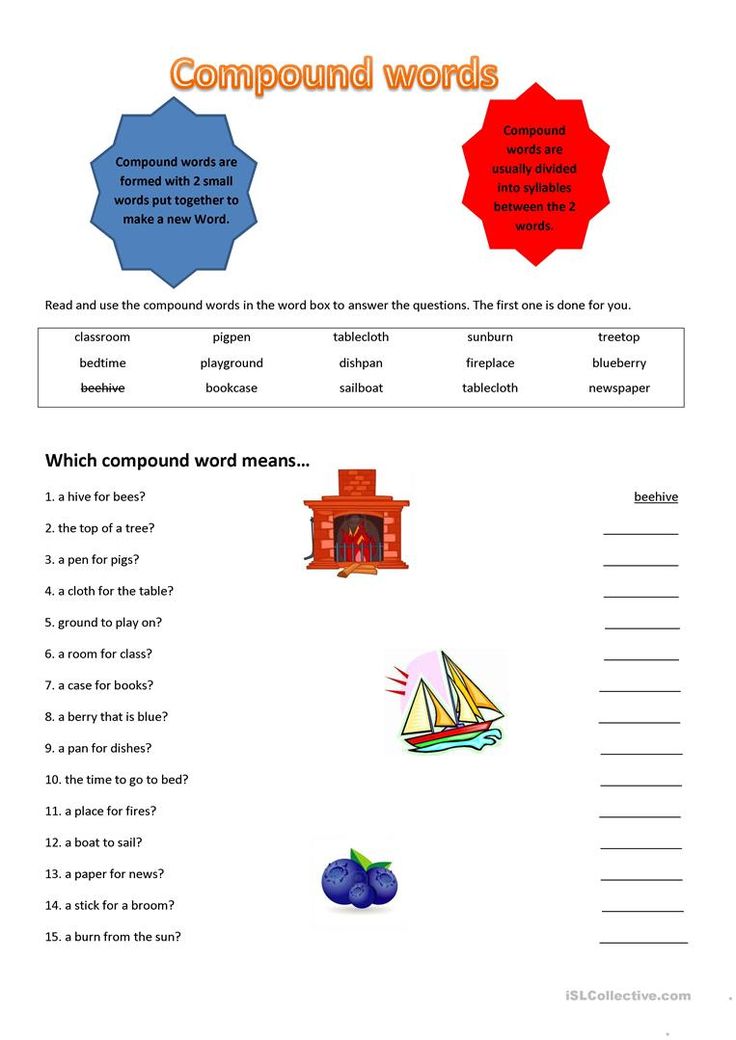
5. Bring, order, in, beekeepers, hives.
Publication address: https://www.prodlenka.org/metodicheskie-razrabotki/351672-slozhnye-slova
How to write complex words that baffle many people
Russian is the largest and most widespread of the Slavic languages. Not surprisingly, many terms can be difficult to spell and pronounce. Try saying or writing the words "internationalize", "self-defense" or "whirlpool" quickly. Most likely, the first time you will not be able to quickly read them, but do not rush to get upset. Use simple tips that will help you speak fluently and beautifully. nine0005
A bit of theory. How do compound words appear?
Compound words are speech structures that have two or more roots in their morphological composition. New words are formed by adding existing words (excellency, eleventh grader), or borrowed from foreign languages (hot dog, deadline, networking). Compound words are formed as follows:
Morphological method.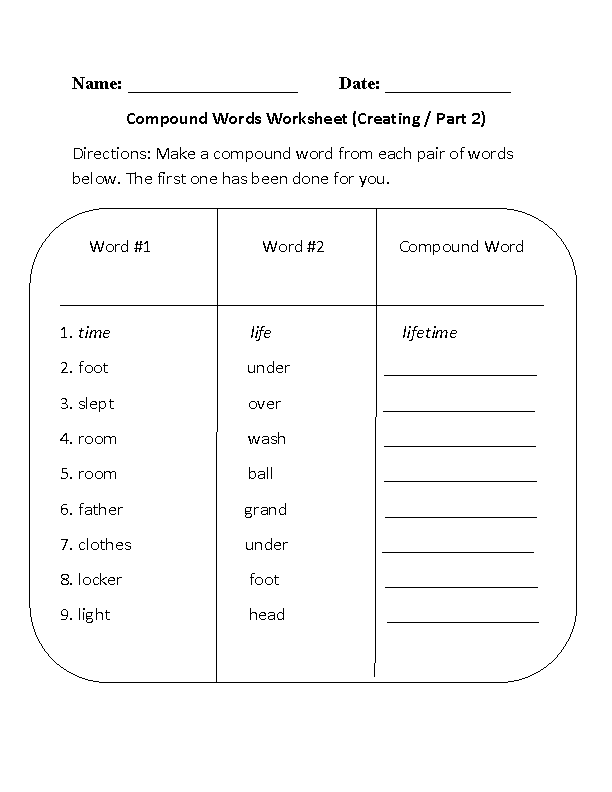 New words are formed on the basis of existing foundations by combining with various affixes, as well as using the connecting letters o, e and e, for example: helicopter, dried fruits, rockfall, water carrier, earthquake, sound combination, housewarming, chair-bed. nine0005
New words are formed on the basis of existing foundations by combining with various affixes, as well as using the connecting letters o, e and e, for example: helicopter, dried fruits, rockfall, water carrier, earthquake, sound combination, housewarming, chair-bed. nine0005
Syntactic way. New formations appear through the addition of independent words or the transition from one part of speech to another: forward looking, crazy, hairdresser, now, immediately.
Words using foreign prefixes anti-, hyper-, super-, trans-, pan-, post-, sub-, super-, ultra-, extra- and others: infrastructure, anti-scientific, transcontinental, arch-reactive, extraordinary, hyperactive , superintendent.
Foreign words. Increasingly, new words began to appear from other languages: outsourcing, know-how, price list, startup, freelancer, traffic, bestseller, blockbuster, image maker. nine0005
Tip 1. For the correct spelling or pronunciation of complex words, mentally determine the way of word formation, divide the speech structure into prefixes and roots, and slowly pronounce the word.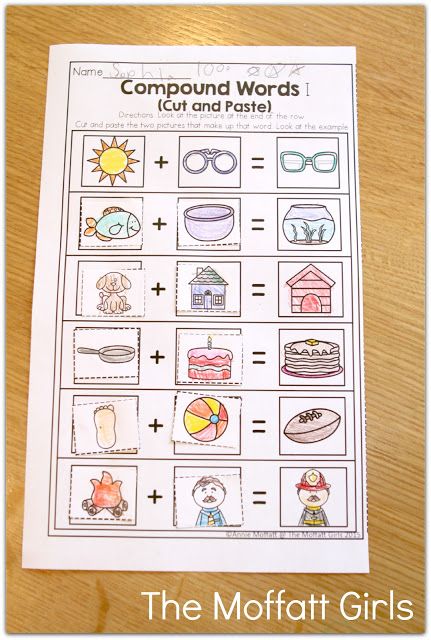
How to deal with stresses in compound words?
As a rule, people understand complex words not only as long speech constructions, but also words that are difficult to immediately emphasize: oil pipeline, solicit, sorrel, carpenter, gas pipeline, marketing, management, blinds, rubber. Here you need to remember a few rules. nine0005
- If the term comes from English, then in most cases the stress will be on the first syllable or as in the original version in a foreign language: jeans, blender, hoodie, broker, rating, selfie. And in the French version, on the last syllable: lampshade, parter, fountain, chassis.
- In compound words ending in meter, in the meaning of a measure of length, we always put the stress on -meter: kilometer, nanometer, micrometer.
- 3. In words ending in -wire, in the meaning of a device for transportation, we put the emphasis on the last syllable: gasoline pipeline, garbage pipeline, light pipeline. Exception: electrical wire.
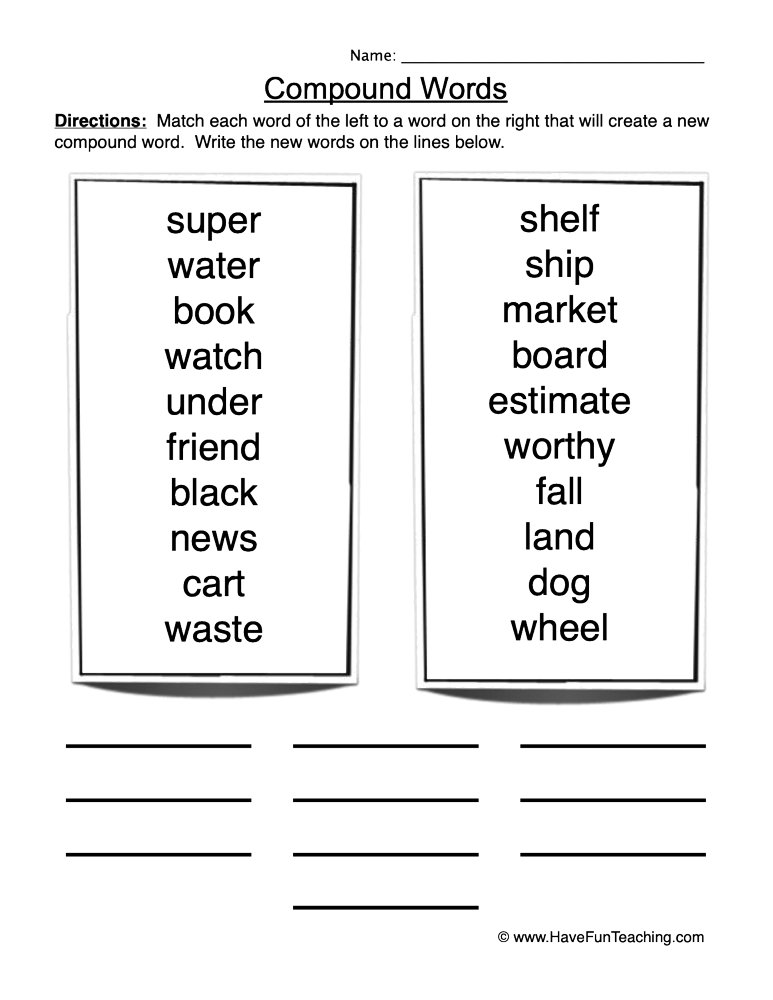
Learn more

